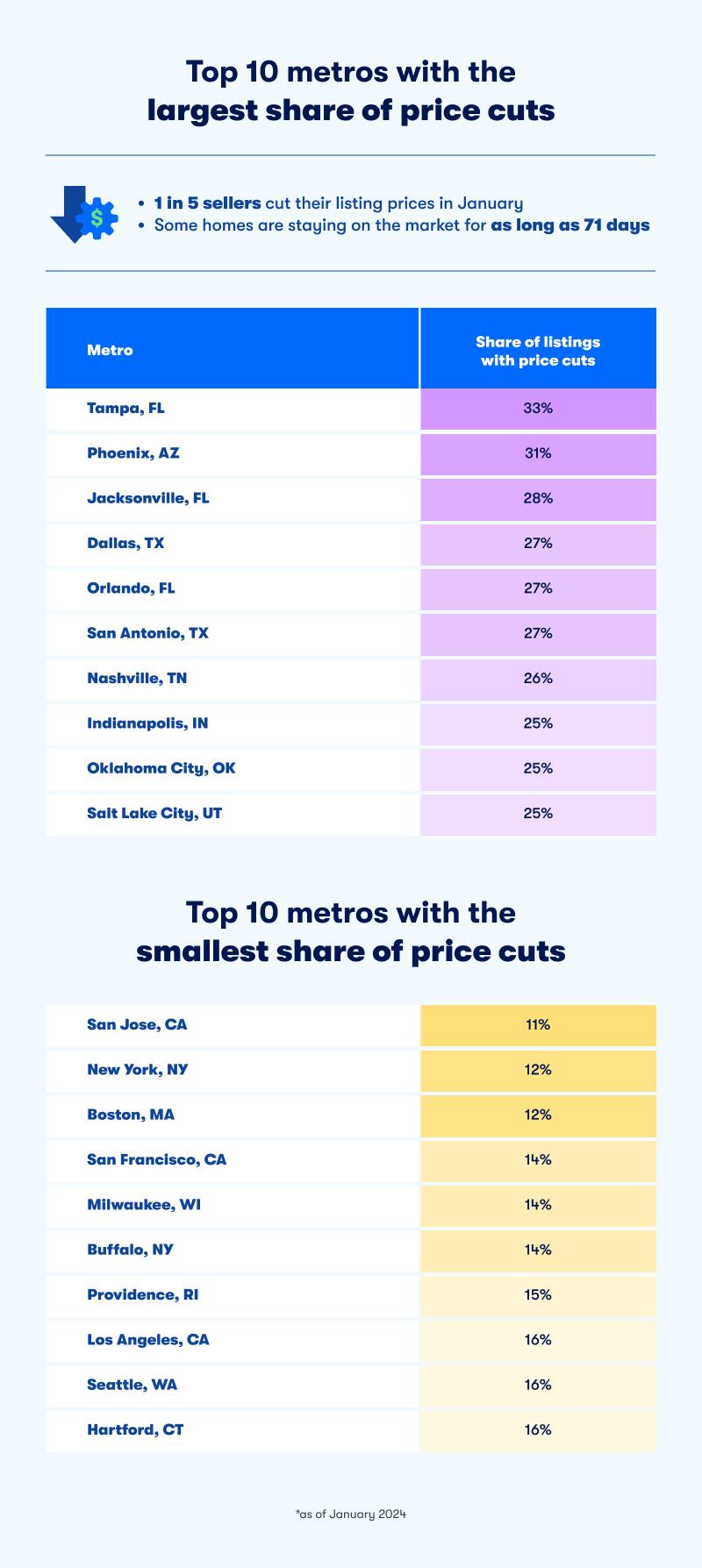Price cuts and an uptick in for-sale listings mark the start of the busiest season for home buyers and sellers.

Spring home buying season — typically the most active time of year for home shopping — is about to begin in earnest with a calmer market. But while the boost in newly listed homes that marks the start of spring is relatively small, it should translate to more options for buyers compared to this time last year. Home shoppers who are prepared to move quickly may even find some relief in price reductions in their market.
“Affordability is still a major challenge, but those shopping now should see early-season price cuts on left-over or mispriced inventory,’’ says Zillow® Chief Economist Skylar Olsen. “However, that may dry up fast as the weather and housing market warms with the season.”
Buyers and sellers are navigating this mixed bag: price cuts and flattening home prices, paired with volatile mortgage rates and relatively stagnant inventory. If you’re looking towards spring wondering what to expect, here’s what our economists are saying about how to prepare.
When does the spring home-buying season begin?
Generally, the spring home shopping season runs from April through June in most of the country. Places with warmer climates tend to start earlier, and those in colder ones tend to have shorter seasons that start later. Warmer weather and school schedules — especially for families looking to move during summer break — are major drivers for the seasonal shopping boost.
How busy any given market gets depends on many things, including the economy, local wages and whether there are sufficient homes for sale to meet buyer demand.
The persistent shortage of listings, coupled with volatile mortgage rates and high home prices, have made for less dramatic seasonal swings in the past year, Olsen says. But the expectation remains that sellers will list their homes in greater numbers this spring, especially since buyers and sellers seem to be adjusting to the higher interest rate environment, she says.
What to know about the spring housing market in 2024
It’s a seller’s market nationally, but buyers still have leverage
Sellers have a slight advantage due to competition for the low number of listings. But sellers still have to meet buyers where they’re at in terms of affordability. Buyers are stretched pretty thin right now and sellers and their agents have to price their homes appropriately for their market if they want to sell quickly and for the price they’re asking.
What to watch for: Keep an eye on mortgage interest rates, which are notoriously hard to predict. If rates swing upward as they did in October 2023, it can push homes further out of reach of buyers and lead to more price cuts, Olsen says. Without a lot of recent sales to draw insight from, she says, judging a list price is especially hard these days.
Inventory is creeping upwards
January listings show a slight improvement from last year’s dreary picture. New listings are up nearly 6% from a year ago, while total listings, which includes homes that have lingered on the market, rose more than 3% compared to last year. “There are slightly more homes for sale than this time last year, and there is still plenty of competition for well-priced houses,’’ says Olsen.
Zillow® data shows that winter lows are deeper than they were before the pandemic, but bounce back in February.
On a monthly basis, the number of homes for sale ticked up by 1.5% from December to January — a welcome sign, but not enough to shift the market in buyers’ favor. “Sellers are still in a good spot,’’ Olsen says. “They’re sitting on a record amount of home equity that they may be looking to cash in.” Until they do, competition for homes is likely to remain stiff.
What to watch for: More homes means greater choices for buyers, and could potentially translate to lower prices or concessions if homes take longer to sell.

Home values are leveling off, and smaller gains are predicted
After eye-popping price increases during the pandemic, home values are finally leveling off, according to Olsen. Nationally, U.S. home values rose 3.6% last year, while about 26% of homes sold above their list price in January — three percentage points less than the previous month.
Only four of the 50 largest metros showed monthly price gains in January. Those markets were:
- Riverside, California (up 0.2%)
- San Diego (0.1%)
- New York City (0.1%)
- Las Vegas (0.1%)
Meanwhile, home values fell slightly in 45 major metro areas. Those with the largest month-over-month dips in January were:
- New Orleans (-1.1%)
- Minneapolis (-0.8%)
- Buffalo (-0.7%)
- Cleveland (-0.7%)
- Pittsburgh (-0.6%)
- Values in Miami remained flat.
It’s important to remember that the situation is far from static in those cities. For instance, Buffalo and Cleveland are included on the list of Zillow’s predictions for hottest markets in 2024. Cities on that list have relatively affordable home prices, and strong employment.
Year-over-year, the picture is more dramatic. Compared to a year ago, homes are worth more in 47 of the 50 largest metro areas. Cities with the biggest gains include Hartford (12.2%), San Diego (9.6%), Providence (8.3%), Boston (8%) and Los Angeles (7.4%).
Metros with the largest year-over-year decline in values are New Orleans (-8.2%), Austin (-6.2%), and San Antonio (-3.2%).
Zillow economists predict that homes nationally will appreciate by 3.5% in 2024, about the same pace as last year.
What to watch for: Greater price stability should help buyers with tight budgets get a better handle on what they can afford without having to constantly adjust for price increases. If you’re searching in a particular market, you can check Zillow’s home values page to see what a typical home there is worth and the share of homes in your market that have had price cuts. Your agent should be well-versed in local market conditions, and can devise a strategy for making an offer that meets the particulars of your situation.

Interest rates remain volatile
No one can accurately predict what interest rates will look like in the next few months. Rates are volatile as the Federal Reserve continues its efforts to tamp down inflation. How that picture unfolds over the next few months is anyone’s guess.
What to watch for: Mortgage rates can add to or lower your monthly payments, sometimes by hundreds of dollars. If you’re planning to buy this spring, talk to a mortgage lender about your options for locking in rates and/or buying a lower interest rate to shrink monthly mortgage payments.
Well-priced homes sell quickly
The typical time it takes for a home to go from listing to under contract was 29 days in January, a day less than a month earlier and two days less than a year ago. Competitively priced homes are selling in about two weeks.
What to watch for: Longer sales times could give you more time to shop and consider homes, but you should be prepared to move quickly if you find a home you love enough to make an offer on. Being prepared means getting prequalified and protecting your credit score so you can get the best mortgage interest rate.
How to prepare to buy this spring
1. Get pre-approved to see what you can afford in your market
“Buyers should prep their credit scores and sellers should prep their properties now,’’ Olsen says. “Attractive listings are going pending in less than a month, and time on market will shrink in the weeks ahead.”Annual income Help$
Calculate by paymentMonthly debts$Down payment$AdvancedCalculator disclaimerHome pricePaymentYou can afford a house up to$268,314Based on your income, a house at this price
should fit comfortably within your budget.$1,837/moFull report
2. Talk to a local agent
Review your wants and needs and talk to a local agent to understand local market conditions in the neighborhoods you’d like to buy.
3. Use Zillow’s search filters to find price cuts
Use Zillow’s search filters to hone in on homes that have been on the market for more than a month. You might find a deal or a seller willing to give concessions. Some homes go unsold because of perceived problems, while others may be more unusual or outdated. Still others may be overpriced.
4. Filter by monthly payment
Integrate your search so that you’re looking at homes that fit within your budget. Zillow allows you to filter search by monthly payment, and every listing will show whether down payment assistance might be available to you for that particular home.
The market continues to evolve, and, as it does, we’ll be sharing with you the latest information and analysis at our Learning Center. Meanwhile, remember that there is no one good time to buy. The only good time is the one that’s right for you and your circumstances. Hang in there!

